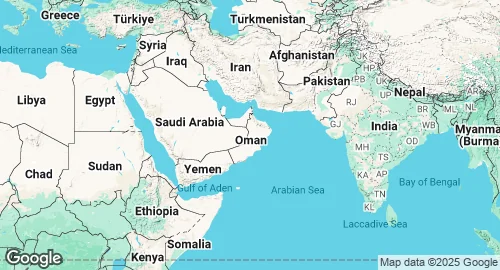Oman Military Forces 🇴🇲
Military Strength Overview
| 🛩️ Air Force | 94 active aircraft |
| ⚓️ Naval forces | 21 ships in fleet |
| 🪖 Active Troops | 42,600 personnels |
| 👮♀️ Paramilitary | 4,400 personnels |
Defense Statistics & Key Metrics
| Population | 5.0 million (2023) |
| GDP | $108.8 billion (2023) |
| GDP per capita | $21550 (2023) |
| Military Budget | $6.0 billion (2024) |
| Share of GDP in Milex | 5.6% (2024) |
| Share of Govt Expenditures | 20.1% (2024) |
| Military spends per capita | $1159 (2024) |
| Inflation Rate | 0.95% (2023) |
| Military Personnel | 47,000 (2020) |
Strategic Overview in 2025
Oman's military posture is fundamentally shaped by its geopolitical position and a long-standing doctrine of strategic neutrality. Situated on the southeastern coast of the Arabian Peninsula, it controls the southern side of the critical Strait of Hormuz, a vital chokepoint for global oil trade. This location grants Oman significant strategic importance but also places it at the center of regional tensions. Historically, Omani foreign and defense policy has been characterized by a careful balancing act, maintaining cordial relations with a wide array of international and regional powers, including the West, Iran, and other Arab states. This neutrality has allowed Oman to carve out a niche as a respected mediator in regional conflicts. The country maintains close defense and security ties with the United Kingdom and the United States, including logistical support facilities, while also engaging in military cooperation with countries like India and China.
Military Forces and Structure
The Sultan's Armed Forces (SAF) are comprised of the Royal Army of Oman, the Royal Navy of Oman, the Royal Air Force of Oman, and the Sultan's Special Forces. The total active personnel strength is estimated to be around 40k, which includes royal household troops. The Royal Army is the largest branch, with approximately 25k personnel, and is organized into several brigades and regiments, including armored, infantry, and reconnaissance units. The Royal Navy, though smaller, is considered one of the most modern in the region, tasked with securing Oman's long coastline and maritime trade routes. The Royal Air Force is also well-regarded and equipped with modern aircraft.
Equipment and Defense Industry
Oman's military has been undergoing a steady modernization process, although it has historically been a major importer of arms, with limited domestic production capabilities. Key suppliers of military hardware include the United Kingdom, the United States, and other European nations. The army's armored units are equipped with Challenger 2 and M60A3 main battle tanks, complemented by a range of armored personnel carriers and reconnaissance vehicles. Recent acquisitions have included Turkish PARS infantry fighting vehicles. The Air Force operates a fleet that includes F-16 fighter jets, and the country has invested in advanced air defense systems. While the domestic defense industry is still in its early stages, there is a stated focus on increasing local capabilities.
Strategic Trends and Outlook
Oman's defense spending has seen fluctuations, influenced by oil prices and regional stability. The country allocated a significant portion of its 2024 budget to defense, reflecting a continued commitment to military preparedness amidst regional turmoil. The primary drivers for defense expenditure include the need to protect its borders, particularly with Yemen, and to maintain a credible deterrent force in a volatile neighborhood. Future modernization efforts are likely to focus on upgrading land forces, including the potential replacement of aging main battle tanks, alongside continued investments in naval and air capabilities. Oman's ability to balance its traditional neutrality with the need for a modern military force will remain a key element of its strategic calculus.
Omani Military Budget History
Population and Military Personnel Trends
GDP and Inflation Rate Trends
Omani Naval Shipbuilding
| Class | Type |
|---|---|
| Qahir Al Amwaj | Missile corvette |
Military Expenditure: SIPRI Milex.
